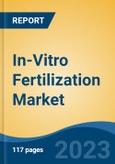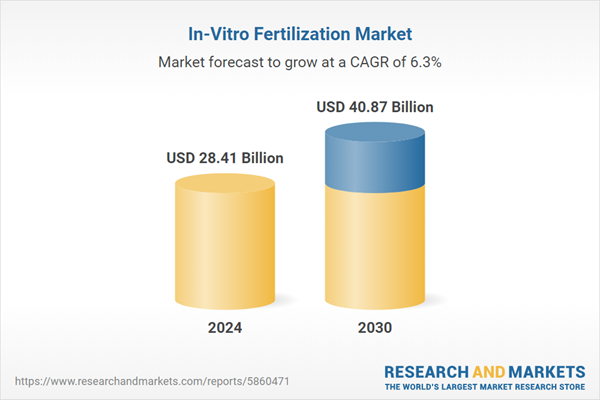Speak directly to the analyst to clarify any post sales queries you may have.
10% Free customizationThis report comes with 10% free customization, enabling you to add data that meets your specific business needs.
IVF has helped millions worldwide overcome infertility. Factors such as aging populations, lifestyle changes, and environmental stressors are contributing to rising infertility, pushing demand for ART solutions. Furthermore, advancements in IVF procedures - like improved embryo culture systems and personalized protocols - have increased success rates. Supportive government initiatives, expanded healthcare access, and growing public awareness are also making IVF more accessible, particularly in emerging economies, where a growing middle class and insurance coverage are further driving market adoption.
Key Market Drivers
Rising Infertility Rates Globally
The increasing global prevalence of infertility is a primary driver of the IVF market. According to the World Health Organization (WHO), one in six individuals faces infertility during their lifetime. Contributing factors include delayed parenthood, lifestyle habits, stress, obesity, and environmental pollutants. Fertility declines significantly in women after age 35, while male infertility is also rising due to reduced sperm quality. Governments and healthcare systems are acknowledging this challenge by supporting access to fertility treatments. In Europe, several countries offer full or partial reimbursement for IVF, while awareness initiatives by NGOs and health agencies are breaking social stigmas and encouraging treatment. Additionally, improved healthcare infrastructure and insurance access in developing nations are further enabling IVF adoption among a broader population base.Key Market Challenges
High Cost of Treatment and Limited Accessibility
Despite growing demand, the high cost of IVF treatment remains a significant barrier, especially in low- and middle-income countries. IVF procedures often require substantial financial investment, with multiple cycles sometimes needed to achieve success. In many regions, fertility treatments are not fully covered by insurance, limiting access to those with financial means. For example, in the United States, IVF is frequently excluded from standard insurance plans, making it less accessible. In contrast, countries like Israel and certain parts of Europe provide public funding, resulting in higher uptake rates. The lack of universal coverage and inconsistent reimbursement structures continue to restrict broader adoption of IVF services.Key Market Trends
Growing Acceptance of Fertility Preservation
Fertility preservation is emerging as a notable trend in the IVF market. Procedures such as egg, sperm, and embryo freezing are gaining popularity among individuals postponing parenthood for personal, career, or medical reasons. This trend is supported by healthcare providers and employers alike, with some companies now including fertility preservation as part of employee benefits. Additionally, fertility preservation is increasingly integrated into cancer care, with guidelines from medical bodies like ASCO recommending early discussions on fertility options before treatment. As public awareness and social acceptance of assisted reproduction continue to rise, the appeal of fertility preservation is expanding the IVF user base beyond traditional infertility patients, indicating strong long-term growth potential.Key Market Players
- The Fertility Center of Las Vegas
- Overlake Reproductive Health
- Gennet City Fertility
- Zita West Clinic
- Fertility Plus Clinic
- Nova IVF Centre and Fertility Clinic
- Bloom IVF Centre
- Progenesis Fertility Center
- Medicana IVF Center
- Medical Park Hospitals
- ART Fertility Clinics
Report Scope:
In this report, the Global In-Vitro Fertilization Market has been segmented into the following categories, in addition to the industry trends which have also been detailed below:In-Vitro Fertilization Market, By Technique:
- ICSI IVF
- Non-ICSI/ Traditional IVF
In-Vitro Fertilization Market, By Product:
- IVF Culture Media
- ICSI Machine
- IVF Incubators
- Cryo-System
- Others
In-Vitro Fertilization Market, By Egg Donor:
- Frozen non-donor
- Fresh non-donor
- Frozen Donor
- Fresh Donor
In-Vitro Fertilization Market, By Infertility:
- Male
- Female
In-Vitro Fertilization Market, By Application:
- Fertility Clinics
- Hospitals
- Others
In-Vitro Fertilization Market, By Region:
- North America
- United States
- Mexico
- Canada
- Europe
- France
- Germany
- United Kingdom
- Italy
- Spain
- Asia-Pacific
- China
- India
- South Korea
- Japan
- Australia
- South America
- Brazil
- Argentina
- Colombia
- Middle East and Africa
- South Africa
- Saudi Arabia
- UAE
Competitive Landscape
Company Profiles: Detailed analysis of the major companies present in the Global In-Vitro Fertilization Market.Available Customizations:
With the given market data, the publisher offers customizations according to a company's specific needs. The following customization options are available for the report.Company Information
- Detailed analysis and profiling of additional market players (up to five).
This product will be delivered within 1-3 business days.
Table of Contents
Companies Mentioned
- The Fertility Center of Las Vegas
- Overlake Reproductive Health
- Gennet City Fertility
- Zita West Clinic
- Fertility Plus Clinic
- Nova IVF Centre and Fertility Clinic
- Bloom IVF Centre
- Progenesis Fertility Center
- Medicana IVF Center
- Medical Park Hospitals
- ART Fertility Clinics
Table Information
| Report Attribute | Details |
|---|---|
| No. of Pages | 185 |
| Published | June 2025 |
| Forecast Period | 2024 - 2030 |
| Estimated Market Value ( USD | $ 28.41 Billion |
| Forecasted Market Value ( USD | $ 40.87 Billion |
| Compound Annual Growth Rate | 6.2% |
| Regions Covered | Global |
| No. of Companies Mentioned | 11 |









